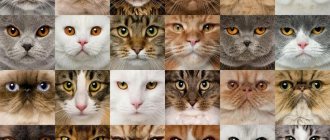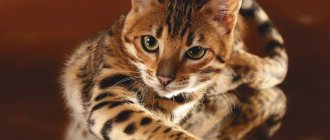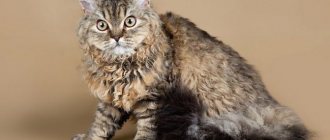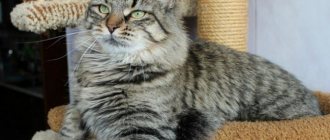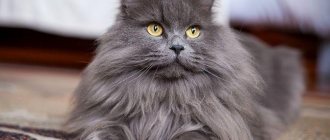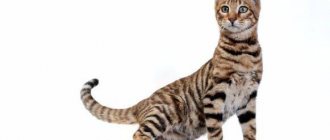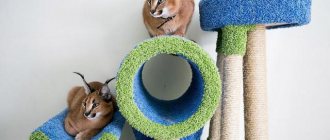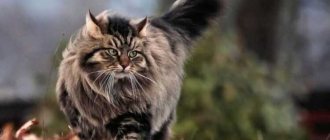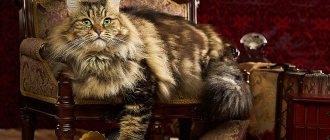Nature and animals07/16/2014
© www.taildom.com
How much do big cats have in common with the motley cat living in your home? This is explained by Susan Bass, director of public relations at the Big Cat Rescue Sanctuary, located in Tampa, Florida (USA). Below we have some amazing videos of big cats acting just like your pets.
Cats that look like a leopard or cheetah
Bengal cat
A small domestic leopard, an intergeneric hybrid of a domestic cat and a wild Bengal cat. Silver cats resemble snow leopards.
Savannah
Miniature cheetah. The athletically graceful cat has large ears and slightly slanted eyes. This is a hybrid of a domestic cat and an African serval.
Safari
Mini leopard. Males can weigh up to 13 kg, and females about 8. The breed is derived from a cross between the Geoffroy wild cat, the shorthaired Siamese and the Bengal cat. The difficulty in the work of felinologists was that a wild cat has 38 chromosomes, and a domestic cat has 36. The hybrid turned out to have 37 chromosomes.
Serengeti
The breed is based on the Bengal cat, Oriental, Abyssinian and tabby cats. The breed is derived entirely from domestic cats.
Egyptian Mau
The oldest breed of cats, which has not changed much over time.
Ocicat
The rare breed was supposed to copy the color of the jungle cat and was obtained by crossing Abyssinian, Siamese and American shorthair cats. He only looks like an ocelot.
Cheeto
Externally, this breed resembles a cheetah, a hybrid of an Ocicat and Bengal cats.
Serval
Servals are wild cats, but there are people who like to keep them at home.
Ocelot
It is quite difficult to keep a “dwarf leopard” at home, but there are nurseries that breed ocelots and servals.
This is interesting: What is the life expectancy of cats at home?
Photos of lions
It probably won’t be a mistake if I say that the most popular wild cat is the lion. It’s not for nothing that he is called the king of beasts.
The lion lives in Africa and India. Few people know, but in India there is a nature reserve in the state of Gujarat called the Gir Forest. So, in this reserve a small population of Indian lions has been preserved.
Lions are the only cats that permanently live in packs. For example, cheetahs can temporarily unite in small groups, for example three individuals. And lions constantly live in a group; a flock of lions is called a pride.
Of all cats, and perhaps of all predators, lions are distinguished by their mane.
These large cats have pronounced sexual dimorphism. What does it mean? In fact, everything is very simple; among lions, boys and girls are very different from each other, not only internally, but also externally. Lionesses do not have such a lush mane.
Lionesses occupy a subordinate position in the pack. They mainly hunt and the flock depends on lionesses for food
See photos of the lioness (many beautiful photos).
By the way, relations within the pride are very cruel. After all, a lion is a predator.
Pixie bob
To develop a breed of cat that resembles a lynx, breeders used short-tailed forest cats. These animals live in the forests of North America. The first cat obtained in this way was named Pixie, which means “Elf” or “Fairy” in English.
The animals are distinguished by a short tail, tufts on the ears and whiskers are possible. Pixies are unpretentious, train well and easily make contact with people.
External features of the lynx
Lynx is a very beautiful animal, with its own distinctive features. She has so-called sideburns on the sides of her head, and tassels on her ears. The lynx's jaws are narrow and powerful, and its nose is wide and large.
The color of the coat depends on the habitat: from fawn-smoky to rusty-red, with small specks in the belly area. The fur is thick, soft, of varying lengths on different parts of the body. The spots on the lynx's body can be pronounced or barely noticeable, concentrated mainly in the back, sides and head. The tassels are always dark in color and can reach 4 cm in length.
In addition to external features, the lynx has excellent hearing, which is partly due to its brushes. For example, in nature she will be able to hear a hare crunching branches 100 meters away from her. Vision is also excellent, the lynx distinguishes colors well. The sense of smell is not very developed; it tracks prey well by following a fresh scent.
California shining cat
The famous screenwriter Paul Casey was involved in the origin of this breed. On his trip to Africa, he decided to preserve the unique colors of wild cats on the skins of domestic animals.
Many breeds took part in the creation of the new species: Manx, British, Siamese, Angora and Abyssinian cats. Eventually, the Californian shining cat appeared, so named for its unusual color.
The breed immediately found many admirers. They say that the Californian cat is a link between humans and wild nature. At the same time, they do not forget to advertise the new breed everywhere.
Photo of a leopard
Next, studying the wild cats of Africa, let's turn our attention to the leopard.
Although the leopard is a large predator, it is inferior in size to lions and tigers. And it’s not a little inferior.
The leopard's main habitat is Africa, although it can be found in Asia all the way to China. But only in Africa is its population in normal condition, if this is how one can write about an animal from the Red Book
Cats that look like pumas
Abyssinians
A recreated ancient breed based on the indigenous breeds of Africa and Asia.
Chausie
The cat weighs about 10 kg, it is somewhat similar to a chito, but it is the result of crossing a wild jungle cat (swamp lynx) and an Abyssinian cat. Undoubtedly, it resembles a mountain lion - a puma.
Photos of tigers
So, moving closer to Asia, let’s pay attention to tigers - this is one of the symbols of Asia.
The wild tiger is one of the most formidable predators. They live and hunt solitarily. Only during the mating season can the female and male hunt together.
Cats that look like lynx
Pikibob
Breeders used North American short-tailed forest cats to create a small version of the lynx.
Kurilian Bobtail
What makes this breed look like a lynx is its short tail and tufts on its ears.
Maine Coon
Giant cats with tufted ears. The shape of the head is very similar to that of a lynx.
Norwegian forest
Powerful bones, wild cat muscles and tufted ears.
Caracal
The desert lynx is a wild cat that is bred in nurseries for domestic keeping.
Caraquet
A fairly new cross between the caracal and the domestic cat that is gaining popularity. Such a cat can weigh up to 15 kg.
This is interesting: TOP 10 medium-sized dog breeds - list, names, weight, photos and descriptions
Where to buy a savannah kitten and its cost
The first generation from crossing with a serval is labeled F1. This means that the kitten has 50% Serval blood. Its further crossing implies the presence of 25% Serval blood (marked F2), etc. up to F5. Cost varies accordingly. The most expensive and most valuable kitten is a kitten marked F1 and F2. The higher the label, the lower the prices.
At the same time, you need to know the fact that the male generation of Savannahs up to the F4 generation is sterile. And F1 kittens have peculiarities in their character. All Savannahs are smart and inquisitive cats, but not all are cute and affectionate. A dear F1 kitten may initially be good-natured and sweet, but there is a chance that wild genes will take their toll. So by the age of 3, i.e., the age when the personality of a smart cat is finally formed, you need to be prepared for this. That is why it is recommended to keep F1 not just in a country house, but in a cottage with a special, comfortably equipped enclosure. But these are all probabilities; it may well be that the chosen savannah will become a pleasant and gentle exception to the rules.
The A1 Savannahs nursery, created by breeder Joyce Sroufe, is considered the best in the breed’s gene pool. But due to the fact that the breed was bred quite recently, and has already gained wide demand among lovers of exotic cats, the Savannah is a very rare and expensive breed, perhaps the most expensive of the existing cat pets. Moreover, the price clearly depends entirely on the labeling. F1 can cost up to or more than 1.5 million rubles. Males, due to their sterility until the 4th generation, are cheaper than females.
The average price of the breed is from 5 to 7 thousand dollars. At the same time, it is hardly possible to find a highly specialized nursery in Russia or near abroad. If a person is seriously thinking about purchasing such a luxurious pet, then the cost of its transportation from the nursery to its destination will have to be added to its cost.
The Savannah is certainly a wonderful breed of domestic cat. A small tame animal, that’s how you can describe this luxurious animal. Smart and inquisitive, beautiful, strongly built and tame. This is probably what captivates exotic lovers when they choose a pet. Man has tamed nature a long time ago, but to tame it so much that it will come and lay its head on his lap is a fundamentally new level that many want to try. Well, if so, then this cat is definitely the choice of a cat lover. But we should not forget to give her the proper care, comfort and affection.
Cats that look like a panther
Burma
The American type of this cat breed, unlike the European one, has more color variations.
Bombay cat
To obtain a miniature black panther, Burmese cats were crossed with black American Shorthairs.
Havana brown
The result of crossing Siamese, regular black and oriental cats. Chocolate panther, with a narrow muzzle and large ears.
Mandalay
The New Zealand Little Panther was created by crossing a Burmese cat and a regular black cat. Later, Abyssinian cats were added to the breed.
Caracal
The caracal is another domesticated wild cat of rare beauty, close in its roots to pumas and servals, and also very similar to the steppe lynx. According to experts, this is a dangerous animal. If at a small age caracal kittens are playful and affectionate, then when they grow up, they become real predators, which are 4-5 times larger than an ordinary cat. Without socialization and improper training at a young age, these cats can pose a serious danger to humans.
Caracals have one feature that often confuses owners - they convey various emotions through ear movements and hissing sounds, which many people find difficult to understand, and often this becomes another reason for anxiety.
It's also worth considering that caracals are not only quite sociable, but also incredibly energetic, and their presence can be destructive.
Caracals are often confused with steppe lynxes
Abyssinian cat
Due to its unique ticked coat color, the Abyssinian cat is very similar to African wild cats. Ticking is alternating light and dark patches on each hair shaft. In addition to their beautiful fur coat, representatives of this breed stand out for their playfulness, high level of intelligence and energetic nature.
Bombay
If you do not take into account the calm, patient and friendly nature of the Bombay, you might think that he is a miniature copy of the black panther. The breed's exotic appearance was achieved by crossing a sable Burmese cat with a black American Shorthair, earning it the nickname "the patent leather baby with the new penny eyes."
Summary
Pets are kept not only for company, but also for the way they look. These cat breeds look wild even though they are purely domesticated.
Regardless of appearance, most, if not all, of these breeds are very calm and loyal. If you want a majestic and beautiful cat, these miniature “big cats” are for you.
Image credit: Kutikova Ekaterina, Shutterstock
Egyptian Mau
Egyptian Mau cats can run at speeds of up to 50 km per hour, making it difficult for them to sit still long enough for you to notice their natural spotted coloring and exotic markings around the eyes. Researchers believe the breed originated in Egypt at least 3,000 years ago, and likely descended from African wild cats.
They take care of themselves a lot
© www.goodfon.ru
Domestic cats spend from 30% to 50% of their waking time grooming themselves. Big cats are just as picky in these matters. "It's to get rid of your own odor," Bass says. “If a gazelle, approaching from the leeward side, smells a tiger waiting for it in ambush, then it will definitely run away. This happens in the wild. Therefore, big cats are forced to constantly lick themselves in order to completely eliminate their smell.” Grooming has a number of other benefits: it helps your cat get rid of parasites and look cool.
Pantheretta
This black beauty was born almost by accident. One of the litters of Bengal cats once gave birth to a black baby. The little one grew and became more and more like a panther in appearance.
The breeders did not ignore the amazing similarity, and selection work led to the creation of a new breed. Pantheretta cannot be bought: the work of researchers is not yet finished. Cats of this breed are very friendly, distinguished by good health and indescribable elegance.
Character and health
Savannah is a cat that is literally burdened with intelligence. This is a really smart breed that can be trained just as well as dogs, learning quite serious commands. Savannah is inquisitive and sociable. If there are other animals in the house besides her, she forms a pack with them, in which she takes the place of leader. Spotted cats have a special affinity for dogs, probably due to their common character.
In terms of health, Savannahs are doing well. In the animal world, it is far from uncommon for artificially bred breeds to have genetic diseases or simply poor health, capable of catching a cold from any draft. Perhaps this is due to the hardy heredity of the wild African serval. But, despite its endurance and good health, it is imperative to vaccinate a small tiger and deworm it.
Safari
One of the largest cat breeds in the world. The body length of the safari is more than a meter, the tail is thick, long and flexible. The thick plush skin requires special care. Safari is a hybrid of a domestic and wild cat.
The following breeds were used for crossing: Geoffroy, Bengals and Siamese cats. Distinctive features: leopard color, well-developed muscles, pronounced cheekbones on the muzzle, the outer corners of the eyes are noticeably raised.
Ocicat
With a coat that can be spotted with tan, chocolate, bluish, lavender or tan and cinnamon, the Ocicat is quite an exotic breed. But there is nothing wild about these cats: the breed was the result of crossing Abyssinians, Siamese and American Shorthair cats.
Savannah
A relatively new breed that was recognized by the Cat Fanciers' Association in 2012, the Savannah is known for its unusual appearance. Large, tall ears are located on the top of the head. The savanna is also characterized by a long neck, long legs and a short, thick tail. In addition, these cats have exotic spotted and striped coats. And this is not surprising, the wild appearance of the savannah was achieved by crossing the African serval with a domestic cat.
Serval photo
Servals also live in Africa. Although they are not large, they compete with cheetahs. And they could probably just be their prey.
The serval is a cat with large ears. She loves to live in thickets of small vegetation, which is why she is called a bush cat.
In the bushes of the serval, its color perfectly camouflages it.
Like the cheetah, the serval is tamed. He is even kept in apartments as a pet.
Toyger
Thanks to its orange color with black or brown stripes and muscular body, the toyger can easily be confused with a real tiger cub. Fortunately, this breed is much nicer (and safer) to humans than a tiger cub and is known for its sweet, calm and friendly nature. The wild appearance of the Toyger was obtained by crossing a Bengal and a domestic tabby shorthair cat.
Which cats are leopard?
Leopard cat breeds are those whose representatives have a spotted color. Outwardly, these cats resemble small leopards. The color of the coat can be varied.
Bengal breed
Bengal breed
The Bengal breed was obtained by crossing a wild Asian cat with a domestic cat in the mid-20th century.
This breed is very popular due to its attractive appearance. The body length ranges from half a meter to eighty centimeters, the tail is cone-shaped. Weight ranges from 4 to 9-10 kilograms. The animal has large black and brown spots on its body.
If there is a lack of attention, a cat can become aggressive.
It is important to monitor your Bengal’s diet, since the stomach is the animal’s most vulnerable organ.
Cats of this breed can be easily trained.
Asherah
Ashera
The breed was the result of crossing an African Serval, an Asian Bengal and a domestic cat.
Ashers grow up to a meter in length, have very long limbs and an expressive predatory look. The weight of the animal is more than 14 kilograms.
Despite their aggressive appearance, the animals are gentle, kind, and easy to care for. Communication with children and other animals does not cause problems. Their behavior is similar to that of ordinary domestic cats.
There are four types of Asherah:
- 1) Ordinary.
- 2) Snow (white color).
- 3) Hypoallergenic (no undercoat that can cause allergies).
- 4) Royal (orange spots on a caramel background).
This breed is considered one of the most expensive.
Savannah
These representatives are the fruit of the union of a domestic cat and a wild Serval cat. Shades of wool can range from brown to black. These animals can reach one and a half meters in length and weigh up to 15 kilograms.
Be sure to read:
The Burmese cat is a short-haired, muscular breed, description and character
The representatives of the breed themselves are very friendly and get along easily with children and other animals.
Savannah cats
For a comfortable existence, the savannah needs a spacious home and freedom of movement.
Characteristics and habits:
- Smart and playful;
- Easy to train;
- Walk calmly on a leash;
- They love to swim in water;
- Easy to learn, they immediately remember the location of the toilet, scratching post, etc.;
- They quickly become attached to their owner.
Serengeti
The birthplace of this breed is the USA. The cats are quite large, with long limbs, large ears and yellow fur around the eyes.
Accustomed to hot climates. The body of the animals is quite muscular, cats are distinguished by elegance and grace in their movements.
Serengeti cat
Serengeti cats are not afraid of dogs, and when they meet them they attack them.
In addition, spotted cats are not afraid of heights; they can climb anywhere without any problems, just to satisfy their curiosity.
This breed is the result of a mixture of Bengal and Abyssinian cats. The development of this breed is still ongoing, and a standard has not yet been developed.
Kanaani
Cat of the Canaani breed (Canaani)
Another name is Canaani. This breed is the result of crossing Bengal, Libyan, domestic, Abyssinian and other cats.
The animal has an independent character.
Kanaani love to walk in the fresh air, quickly adapt to new conditions, and do not require scrupulous care. When walking with the owner, it is best for the cat to purchase a leash.
The color of the animal's coat varies from sandy to brown with spots of various colors. The muscles are well developed, the legs are long, which allows the animals to run at high speed. The eyes are almond-shaped, and the ears have tufts.
Arabian Mau
Arabian Mau
Wool has no undercoat. Color ranges from white to black, with some dark colors having no spots. The most common representatives are brown or gray.
Cats have well-developed muscles, a narrow tail and long legs. The average weight is 7 kilograms. Males are much larger than females.
Be sure to read:
The Ural Rex is a Russian aboriginal breed of curly-haired cat with curly hair.
The eyes are oval in shape, the ears are large, the color of the eyes depends on the color of the coat. Like many other leopard breeds, the cat easily becomes attached to its owner and is friendly towards children.
Mau cat
The Mau breed received official status in 2008. Characteristics of the Arabian Mau:
- Slender, but not emaciated body with long legs.
- Coarse coat that fits tightly to the body.
- Black, white, gray and brown colors with slight variations in shades are acceptable.
Cat care includes hygiene procedures and weekly walks.
Asian tabby
Asian tabby cat
This breed was bred in England in the 80s of the 20th century. To get such an animal, a Burmese cat was crossed with a Persian chinchilla. The result was a strong and muscular shorthaired cat.
Each representative of the breed has a special spot on its neck. The eyes, nose and mouth have dark edging. Spots in the form of rings are visible on the tail.
There are 4 types of breed color:
- standard spotted;
- marble;
- brindle;
- ticked.
Color varies from blue to dark brown.
Housey
This is a relatively young cat breed that was created by crossing a domestic cat with a wild jungle cat (Felis chaus). They can grow to almost a meter in length and weigh 4-7 kilograms or more. As with other hybrid Savannah or Bengal cats, male Housies from the first few generations are usually sterile, with the F4 and F5 generations considered the most suitable for showing.
They rub against things
© www.fresher.ru
This is how they mark their territory. According to Bass, in both big and domestic cats, “glandular scent is present everywhere, especially in the face area. So they rub their faces against all sorts of things. It could be the corner of a sofa, or a cage, or a tree. Or you".
© www.vsenichego.ru
Big cats also mark their territory, leaving scratches. All cats are solitary (with the exception of lions, who live in prides). Bass says: “Tiger cubs, for example, are with their mothers for two years and then become independent. If you are a 2-year-old male tiger, you are wandering in the wild, and suddenly you see a tree scratched at a height of 2.5 to 3 meters, then these scratches appeared there because the tiger living there stood on its hind legs paws, stretched out his front paws high, and left marks. This is like a message to every tiger who comes to this territory. It says: this is how big I am, I can scratch a tree even at this height. And if you can’t scratch a tree higher than I can, you’d better get out of here quickly.”
Serengeti
The goal of breeding the Serengeti breed was to create a cat that resembled the wild Serval, but did not contain any of its ancestry. The first Serengeti was created by Karen Sauzman in 1994 by crossing a Bengal and an Oriental cat. Subsequent offspring were crossed with many other types of cats to perfect the breed. However, the Serengeti ancestry includes genes from the wild Bengal cat, which was used to create the domestic Bengal cat. Cats of this breed have long ears and legs, like a serval. They are very mobile, active, and sociable.
Didn't find what you were looking for? Use the site search form
They love to roll out toilet paper rolls...
© www.freehdwall.com
This situation is familiar to anyone who has a kitten: you come home, go into the bathroom, and find a lot of torn toilet paper there. When Big Cat Rescue placed rolls of toilet paper in the enclosures of servals, lynxes and ocelots, they discovered that even the big cats loved playing with the white paper. "They become more curious when they find something new in their immediate vicinity," Bass says. Plus, it's just fun! (Yes, it’s fun. For them. But not for the person who then has to put away and rewind all this paper).
